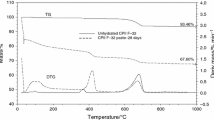Abstract
The kinetics and even the mechanism of cement reaction with water can be successfully investigated by use of microcalorimetry. In this study this method was applied to follow the hydration of the new family of portland cements containing C12A7 * and C11A7·CaF2 addition as well as special cement with C3A replacement by calcium sulphoaluminate. It has been found that C11A7·CaF2 acted as hydration retarder. The heat evolution curves for C12A7 containing samples without CaF2 are very similar to those for the reference portland cement samples. XRD and SEM studies confirm the results described above, relating to the retardation of alite hydration. The process is positively modified by the addition of anhydrite. In the presence of calcium sulphoaluminate (4CaO·3Al2O3·SO3) the hydration at early stage occurs with the rapid formation of large amount of the ettringite phase. The calcium fluoride acts as a set retarder. The full compatibility of calorimetry with SEM and XRD results should be underlined.
Zusammenfassung
Mittels Mikrokalorimetrie kann die Kinetik und selbst der Mechanismus der Zementreaktion mit Wasser erfolgreich untersucht werden. Vorliegend wurde diese Methode zur Verfolgung der Hydratation einer neuen Reihe von Portlandzements mit Gehalt an C12A7- und C11A7CaF2-Zusatz sowie von Spezialzement mit C3A-Ersatz durch Calciumsulfoaluminat angewendet. Man fand, daß C11A7CaF2 als Hydratationsbremsmittel wirkt. Die Kurven für die Wärmefreisetzung für C12A7-haltige Proben ohne CaF2 ähneln sehr denen für die als Bezugssubstanz verwendeten Portlandzements. Röntgendiffraktions- und SEM-Untersuchungen bestätigen die obenbeschriebenen Ergebnisse bezüglich der Verzögerung der Alithydratation. Durch Zusatz von Anhydrit wird der Prozeß positiv modifiziert. In Gegenwart von Calciumsulfoaluminat (4CaO·3Al2O3·SO3) erfolgt die Hydratation in frühen Schritten unter schneller Bildung einer großen Menge Ettringitphase. Calciumfluorid wirkt als Verzögerungsmittel. Die volle Übereinstimmung von Kalorimetrie mit SEM- und Röntgendiffraktionsuntersuchungen wird betont.
Similar content being viewed by others
References
W. Kurdowski and F. Sorrentino, Special Cements, Structure and Performance of Cements, ed. F. Barnes, Applied Science Publisher, London 1983, p. 489.
B. Cottin and C. Vibert, Cement-Wapno-Gips, 7 (1976) 196 (in Polish)
I. Odler, The possibilities of increasing SO3 content in cement, in: Advances in Cement Manufacture and Use, ed. E. Gartner, Engineering Foundation, New York, 1989, p. 303.
Author information
Authors and Affiliations
Additional information
In cement chemistry the following notation is used:C=CaO,A=Al2O3,S=SiO2,H=H2O etc. for the main oxide constituents of portland cement clinker and hydrates.
Rights and permissions
About this article
Cite this article
Kurdowski, W., Nocuń-Wczelik, W. Calorimetric studies of special cements. Journal of Thermal Analysis 45, 923–930 (1995). https://doi.org/10.1007/BF02547459
Issue Date:
DOI: https://doi.org/10.1007/BF02547459




